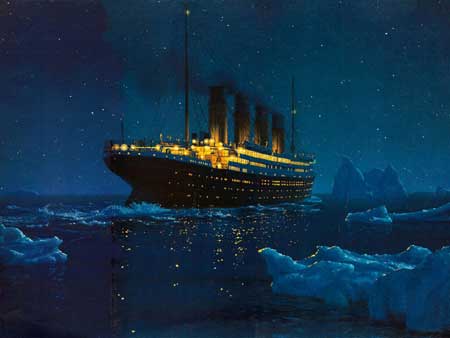当前位置: Language Tips> 双语新闻
 |
|
Maybe we can fault freak atmospheric conditions that caused a mirage or an even rarer astronomical event that sent icebergs into shipping lanes. |
|
After an entire century that included two high-profile government investigations and countless books and movies, we're still debating what really caused the Titanic to hit an iceberg and sink on that crystal-clear chilly night. Maybe there's more to blame than human folly and hubris. Maybe we can fault freak atmospheric conditions that caused a mirage or an even rarer astronomical event that sent icebergs into shipping lanes. Those are two of the newer theories being proposed by a Titanic author and a team of astronomers. New theories and research are important "but at its most basic what happened is they failed to heed warnings and they hit the iceberg because they were going too fast," said James Delgado, director of maritime heritage at the National Oceanic and Atmospheric Administration. One of the novel new theories says Titanic could have been the victim of a mirage that is similar to what people see in the desert. It's the brainchild of Tim Maltin, a historian who has written three books about Titanic. The unusually cold sea air caused light to bend abnormally downward, Maltin said. The Titanic's first officer, William McMaster Murdoch, saw what he described as a "haze on the horizon, and that iceberg came right out of the haze," Maltin said, quoting from the surviving second officer's testimony. Other ships, including those rescuing survivors, reported similar strange visuals and had trouble navigating around the icebergs, he said. British meteorologists later monitored the site for those freaky thermal inversions and said 60 percent of the time they checked, the inversions were present, Maltin said. The same inversions could have made the Titanic's rescue rockets appear lower in the sky, giving a rescue ship the impression that the Titanic was smaller and farther away, Maltin said. Physicists Donald Olson and Russell Doescher at Texas State University have another theory in Sky &Telescope magazine that fits nicely with Maltin's. Olson — who often comes up with astronomical quirks linked to historical events — said that a few months earlier, the moon, sun and Earth lined up in a way that added extra pull on Earth's tides. The Earth was closer to the moon than it had been in 1,400 years. The unusual tides caused glaciers to calve icebergs off Greenland. Those southbound icebergs got stuck near Labrador and Newfoundland but then slowly moved south again, floating into the shipping currents just in time to greet the Titanic, the astronomers theorized. Maltin said the icebergs also added a snaking river of super-cold water that magnified the mirage effect. (Read by Brian Salter. Brian Salter is a journalist at the China Daily Website.) (Agencies) |
泰坦尼克号沉没一百周年之际,我们仍然在讨论是什么原因使它在如此晴朗而寒冷的夜晚撞上了冰山,沉没海底。这一百年间,关于沉船事故已经进行了两次知名的政府调查,还有无数的书籍和电影问世。 也许除了人们的愚蠢和傲慢自大,事故还有其它原因。也许我们可以归罪于反常的大气状况导致出现了海市蜃楼,或是更加稀奇的天文现象使得冰山进入了航线。这些是一位泰坦尼克号的作者和几位天文学家提出的两种最新理论。 海洋和大气管理局的海事遗产主管詹姆斯-迪加多说,新的理论和研究很重要,“但发生的最基本的事实是,船员没能留心警报,而且由于船速过快而撞上了冰山。” 最新的一种理论认为,泰坦尼克号事故有可能是海市蜃楼导致的,就像人们在沙漠里看到的那样。这一理论出自历史学家蒂姆-马丁,他已经写了三本有关泰坦尼克号的著作。 马丁说,异常寒冷的海洋空气使得光线反常地向下弯曲。根据幸存的第二副驾驶的证词,泰坦尼克号的大副威廉-麦克马斯特-默多克描述称,他看到了“海平面上的阴霾,而冰山正好从阴霾中出现”。 其它船只,包括幸存者,也报告称看到了类似的奇异景象,而且在冰山附近驾驶船只时感觉难以操纵。 马丁说,英国气象学家随后在该地对这一奇异的逆温现象进行了监测,结果在60%的监测时间里,都存在这种逆温现象。 马丁还说,这一逆温现象也使泰坦尼克号发射的遇难信号弹看起来比天空更低,使得救援船只产生了错觉,以为泰坦尼克号体积更小,距离也更远。 美国德州州立大学的物理学家唐纳德-奥森和罗素-多斯彻在《天空与望远镜》杂志上发表了另一种理论,和马丁的说法恰好吻合。奥森说,事发几个月前,月亮、太阳和地球的排列方式增大了地球的潮汐力。当时地球和月亮之间的距离是1400年以来的最短距离。奥森经常将历史事件和天文异象联系起来。 这种不寻常的潮汐使得格陵兰的冰川崩裂成冰山。这些向南漂移的冰山卡在了拉布拉多和纽芬兰一带海域,之后再次缓慢南移,漂移到了航流上,正好遇到泰坦尼克号。马丁表示这些冰山也使海面出现了蜿蜒的超级冰冷的水流,放大了海市蜃楼效应。 相关阅读 (中国日报网英语点津 Julie 编辑:陈丹妮) |
|
Vocabulary: hubris: 傲慢。狂妄自大 mirage: 海市蜃楼 brainchild: (某人的)创作,独创的观念 first officer: (商船上的)大副 |
上一篇 : 日本人25岁智慧达顶峰?
下一篇 : 临时工让正式职工“破财又伤身”
电话:8610-84883645
传真:8610-84883500
Email: languagetips@chinadaily.com.cn